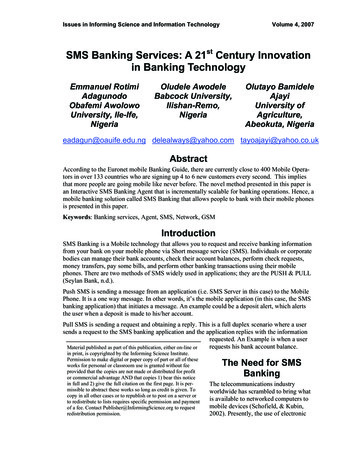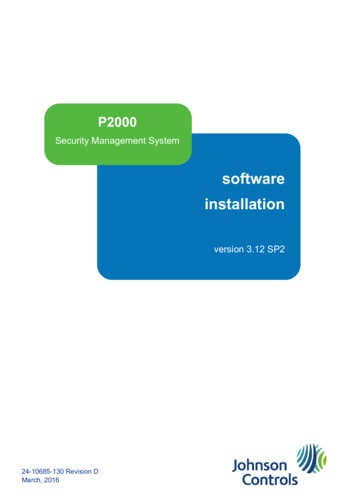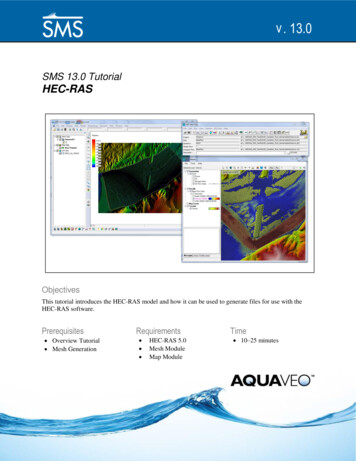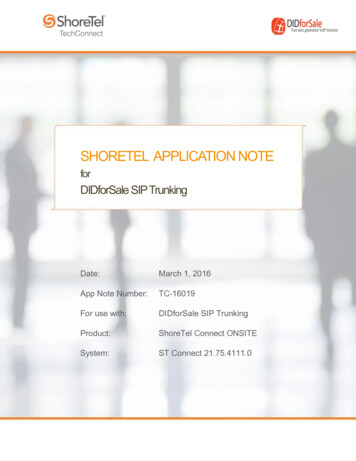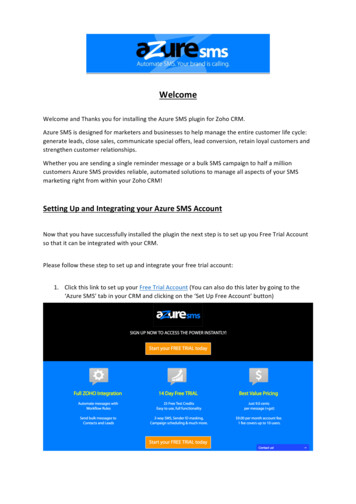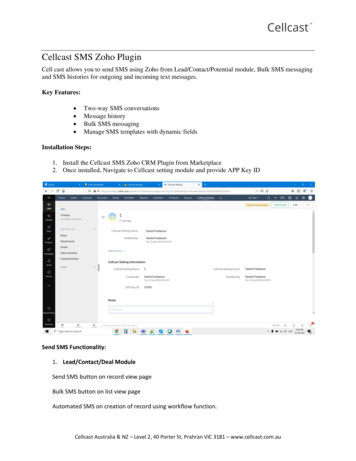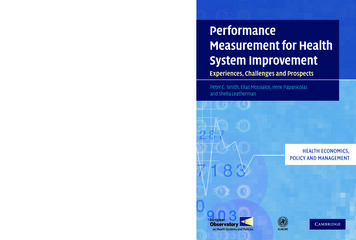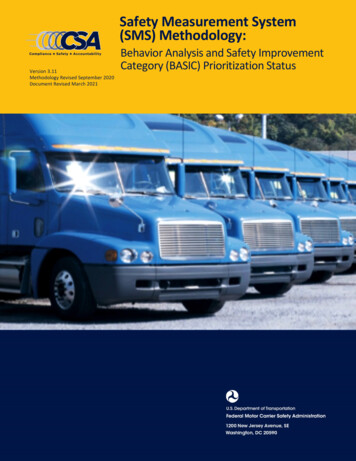
Transcription
Safety Measurement System(SMS) Methodology:Version 3.11Methodology Revised September 2020Document Revised March 2021Behavior Analysis and Safety ImprovementCategory (BASIC) Prioritization Status
Table of ContentsIntroduction . 1-1Purpose of this Document . 1-2Design of the SMS BASIC Prioritization Status . 2-1Description of the BASICs . 2-1Data Sources . 2-2On-Road Design Features . 2-4Violation Severity . 2-4Adjudicated Citations . 2-4Crash Severity . 2-5Not Preventable Crashes . 2-5Time Weights. 2-5Normalization . 2-5Segmentation . 2-6Safety Event Groups . 2-6Data Sufficiency . 2-6Percentile Rank. 2-6Investigation Features . 2-7Acute and Critical Violations . 2-7BASIC Prioritization Status. 2-8BASIC Intervention Thresholds . 2-8SMS BASIC Prioritization Status Methodology . 3-1Unsafe Driving BASIC Prioritization Status Assessment . 3-1On-Road Performance . 3-1Intervention Thresholds . 3-5Investigation Results . 3-6Crash Indicator BASIC Prioritization Status Assessment – Not Publicly Available . 3-6On-Road Performance . 3-6Intervention Thresholds . 3-10HOS Compliance BASIC Prioritization Status Assessment . 3-10On-Road Performance . 3-10March 2021i
Intervention Thresholds . 3-12Investigation Results . 3-12Vehicle Maintenance BASIC Prioritization Status Assessment. 3-13On-Road Performance . 3-13Intervention Thresholds . 3-15Investigation Results . 3-15Controlled Substances/Alcohol BASIC Prioritization Status Assessment . 3-16On-Road Performance . 3-16Intervention Thresholds . 3-18Investigation Results . 3-18HM Compliance BASIC Prioritization Status Assessment – Not Publicly Available . 3-18On-Road Performance . 3-18Intervention Thresholds . 3-20Investigation Results . 3-21Driver Fitness BASIC Prioritization Status Assessment. 3-21On-Road Performance . 3-21Intervention Thresholds . 3-23Investigation Results . 3-23Insurance/Other Indicator Prioritization Status Assessment – Not Publicly Available . 3-24Investigation Results . 3-24SMS Improvement Process . 4-1Appendix A . A-1Appendix B . B-1March 2021ii
List of TablesTable 2–1. Impact of Adjudicated Citation Result on Violation in SMS. 2-5Table 2–2. BASIC Intervention Thresholds . 2-8Table 2–3. Passenger Carrier Intervention Threshold Definition . 2-9Table 2–4. HM Intervention Threshold Definition. 2-9Table 3–1. VMT per Average PU for Combination Segment . 3-4Table 3–2. VMT per Average PU for Straight Segment . 3-4Table 3–3. Safety Event Groups for Unsafe Driving BASIC: Combination Segment . 3-5Table 3–4. Safety Event Groups for Unsafe Driving BASIC: Straight Segment . 3-5Table 3–5. Intervention Thresholds for the Unsafe Driving BASIC . 3-5Table 3–6. Crash Severity Weights for Crash Indicator BASIC . 3-7Table 3–7. VMT per Average PU for Combination Segment . 3-8Table 3–8. VMT per Average PU for Straight Segment . 3-8Table 3–9. Safety Event Groups for the Crash Indicator BASIC: Combination Segment . 3-9Table 3–10. Safety Event Groups for the Crash Indicator BASIC: Straight Segment . 3-9Table 3–11. Intervention Thresholds for the Crash Indicator BASIC . 3-10Table 3–12. Safety Event Groups for the HOS Compliance BASIC. 3-12Table 3–13. Intervention Thresholds for the HOS Compliance BASIC. 3-12Table 3–14. Safety Event Groups for the Vehicle Maintenance BASIC . 3-15Table 3–15. Intervention Thresholds for the Vehicle Maintenance BASIC . 3-15Table 3–16. Safety Event Groups for Controlled Substances/Alcohol BASIC . 3-17Table 3–17. Intervention Thresholds for the Controlled Substances/Alcohol BASIC. 3-18March 2021iii
Table 3–18. Safety Event Groups for the HM Compliance BASIC . 3-20Table 3–19. Intervention Thresholds for the HM Compliance BASIC . 3-21Table 3–20. Safety Event Groups for the Driver Fitness BASIC . 3-23Table 3–21. Intervention Thresholds for the Driver Fitness BASIC . 3-23March 2021iv
List of AbbreviationsATRIAmerican Transportation Research InstituteBASICBehavior Analysis and Safety Improvement CategoryCDLCommercial Driver’s LicenseCMVCommercial Motor VehicleCPDPCrash Preventability Determination ProgramCRWGCompliance Review Work GroupCSACompliance, Safety, AccountabilityDIRDriver Information ResourceDSMSDriver Safety Measurement SystemEOBRElectronic Onboard RecorderFAST ActFixing America’s Surface Transportation ActFMCSAFederal Motor Carrier Safety AdministrationFMCSRsFederal Motor Carrier Safety RegulationsHMHazardous MaterialsHMRsHazardous Materials RegulationsHMSPHazardous Materials Safety PermitHOSHours-of-ServiceIEPIntermodal Equipment ProviderL&ILicensing and InsuranceMCMISMotor Carrier Management Information SystemMCSAPMotor Carrier Safety Assistance ProgramOOSOut-of-ServiceOP-ModelTestOperational Model TestPPOBPrincipal Place of BusinessPUPower UnitRDRRequest for Data ReviewSAFERSafety and Fitness Electronic Records SystemMarch 2021v
SafeStatMotor Carrier Safety Status Measurement SystemSISafety InvestigatorSMSSafety Measurement SystemUMTRIUniversity of Michigan Transportation Research InstituteU.S. DOTU.S. Department of TransportationVMTVehicle Miles TravelledMarch 2021vi
IntroductionThe Federal Motor Carrier Safety Administration’s (FMCSA) core mission is to prevent crashes, injuries,and fatalities related to large trucks and buses on our Nation’s roads. An important step in achieving themission is to identify unsafe motor carriers and prioritize FMCSA enforcement resources on those thatpose the greatest safety risk. The Safety Measurement System (SMS) is FMCSA’s workload prioritizationtool. FMCSA uses the SMS to identify carriers with potential safety problems for interventions 1 as part ofthe Agency’s safety compliance and enforcement program called Compliance, Safety, Accountability(CSA).The SMS is designed to incorporate the safety-based regulations related to motor carrier operations.The SMS assesses compliance and prioritizes carriers for interventions based on their on-roadperformance and investigation results. On-road performance includes data collected from roadsideinspections and crash reports; investigation results include violations discovered within the previous 12months.The SMS assesses motor carrier on-road performance and compliance by organizing data into sevenBehavior Analysis and Safety Improvement Categories (BASICs): Unsafe Driving, Crash Indicator, Hoursof-Service Compliance, Vehicle Maintenance, Controlled Substances/Alcohol, Hazardous MaterialsCompliance (HM), and Driver Fitness.In each BASIC, the SMS calculates a quantifiable measure of a motor carrier’s performance. The SMSgroups carriers by BASIC with other carriers that have a similar number of safety events (e.g., crashes,inspections, or violations). The SMS then ranks these carriers based on their BASIC measure, assigningthem a percentile from 0‒100 (the higher the percentile, the worse the safety performance).The SMS also prioritizes carriers for interventions using a set of violations known as Acute and CriticalViolations. This set of violations is defined in the current Safety Fitness Procedures (49 CFR 385 AppendixB). If a carrier has been found with one or more Acute and/or Critical Violations within the past 12months during an investigation, the carrier will receive an “Alert” in the corresponding BASICs. The SMSuses both the BASIC percentiles and Acute and Critical Violations to highlight safety performance issueswithin each BASIC and prioritize carriers for interventions.Various studies have shown that the SMS is effective in helping the Agency identify high crash-riskcarriers for interventions. FMCSA’s 2014 SMS Effectiveness Test found that six of the seven BASICs identify carrierswith a higher future crash rate than the national average for interventions and in all BASICs1An intervention is an action used by FMCSA to encourage or enforce compliance with Federal regulations. Types of interventions includewarning letters, roadside inspections, and investigations.March 20211-1
SMS Methodology 1. Introductionin the for-hire combination carrier segment. 2 The report also found that carriers with one ormore BASICs prioritized for interventions have a 79% higher future crash rate compared toactive carriers with no BASICs prioritized for interventions.A 2012 American Transportation Research Institute (ATRI) report analyzed the five publiclyavailable BASICs. 3 The report showed that carriers with an “Alert” demonstrated highercrash rates than those without “Alerts” in four BASICs. 4 In addition, the report showed thatcrash risk increases as the number of “Alerts” increases.The 2011 independent evaluation of the CSA Operational Model Test found that five of theseven SMS BASICs demonstrated a strong relationship to crash risk. 5Purpose of this DocumentThe purpose of this document is to explain how motor carriers’ safety performance and compliancestatus in the SMS BASICs causes them to be identified and prioritized for FMCSA interventions. Motorcarriers highlighted with a(i.e., “Alert”) symbol in the corresponding BASIC are prioritized forinterventions or further monitoring. This BASIC prioritization status information is currently displayed onthe SMS Website. 6This revised version of the SMS Methodology document incorporates and consolidates information onhow investigation results impact a carrier’s prioritization status in each BASIC. These revisions to theSMS Methodology document are intended to make information regarding the SMS methodology easierto access and understand, but do not alter the methodology itself. A brief summary of each section ofthe document appears below.Section 2. Design of the SMS BASIC Prioritization Status: describes the seven BASICs, the datasources, and how on-road performance and/or Acute and Critical Violations from priorinvestigations are used to determine BASIC prioritization status.Section 3. SMS BASIC Prioritization Status Methodology: explains the methodology used todetermine percentiles and how the percentiles and/or investigation results for each BASIC affectthe carrier’s BASIC prioritization status.Section 4. SMS Improvement Process: outlines the Agency’s improvement process for the SMS.FMCSA, The Carrier Safety Measurement System (CSMS) Effectiveness Test by Behavior Analysis and Safety Improvement Categories (BASICs),January 2014. The full report is available at: https://csa.fmcsa.dot.gov/Documents/CSMS Effectiveness Test Final Report.pdf.23ATRI, Compliance, Safety, Accountability: Analyzing the Relationship of Scores to Crash Risk, October 2012, http://atri-online.org.4FMCSA prioritizes carriers with “Alerts” for interventions.University of Michigan Transportation Research Institute (UMTRI), Evaluation of the CSA 2010 Operational Model Test, August n-of-the-CSA-Op-Model-Test.pdf.5The SMS Website is available at: https://ai.fmcsa.dot.gov/sms/. Pursuant to the Fixing America’s Surface Transportation (FAST) Act of 2015,the SMS results previously available on the SMS Website related to property carrier’s compliance and safety performance are no longeravailable for public display. Property carriers must log in to view their complete SMS results.6March 20211-2
SMS Methodology1. IntroductionAppendix A: contains tables listing all of the violations used in the SMS by BASIC, along with thecorresponding Federal Motor Carrier Safety Regulations (FMCSRs) or Hazardous MaterialsRegulations (HMRs).Appendix B: provides a history of the changes made to the SMS methodology to date.March 20211-2
Design of the SMS BASIC Prioritization StatusThe Safety Measurement System (SMS) is the Federal Motor Carrier Safety Administration’s (FMCSA)workload prioritization tool. FMCSA uses the SMS to assess noncompliance by analyzing on-roadperformance data collected from inspections, crash reports, and Acute and Critical Violations discoveredduring prior investigations. The SMS uses this safety data to assess carriers in the seven BehaviorAnalysis and Safety Improvement Categories (BASICs). The BASICs are: Unsafe Driving, Crash Indicator,Hours-of-Service (HOS) Compliance, Vehicle Maintenance, Controlled Substances/Alcohol, HazardousMaterials (HM) Compliance, and Driver Fitness.Since its inception, the SMS has provided the motor carrier industry and other safety stakeholders withmore comprehensive, informative, and regularly updated safety performance data. 7 Findings from theSMS allow the evaluated carriers to identify safety areas where they need to improve. In turn, thisinformation empowers motor carriers and other stakeholders involved with the motor carrier industryto make safety-based business decisions using all available sources of information, including safetyfitness determinations (ratings) in FMCSA’s Safety and Fitness Electronic Records (SAFER) system, andauthority and insurance status in FMCSA’s Licensing and Insurance (L&I) system. Access to all of thisinformation was centralized in the August 2014 revisions to the SMS public display.Description of the BASICsThe BASICs incorporate violations of the Federal Motor Carrier Safety Regulations (FMCSRs) and theHazardous Materials Regulations (HMRs), and are organized to focus on behaviors that may cause orincrease the severity of crashes. The BASICs are defined as follows: 7Unsafe Driving BASIC—Operation of commercial motor vehicles (CMVs) in a dangerous orcareless manner. Example violations include: speeding, reckless driving, improper lanechange, texting while operating a CMV, not wearing safety belts.Crash Indicator BASIC (not publicly available)—Historical pattern of crash involvement,including frequency and severity. This BASIC is based on information from State-reportedcrashes that meet reportable crash standards. Crashes found to be not preventable byFMCSA’s Crash Preventability Determination Program (CPDP) will be listed on the SMSWebsite as “Reviewed – Not Preventable,” but excluded from a carrier’s measure andpe
1 as part of the Agency’s safety compliance and enforcement program called Compliance, Safety, Accountability (CSA). The SMS is designed to incorporate the safe



